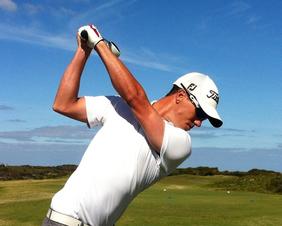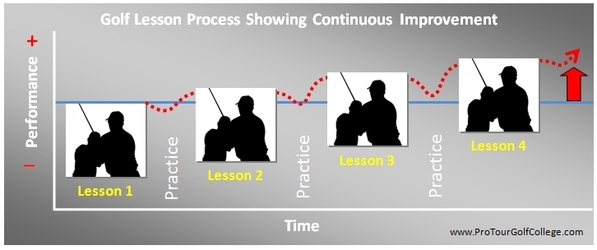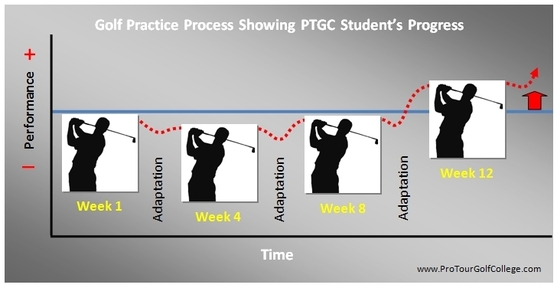 How do you know that the way you practice you golf skills is the correct way? Is there a correct way to practice golf? We know there is, and we’re almost 100 percent sure that the way most elite golfers we’ve observed are going about it is completely wrong! In this weeks article we’re going to look specifically at a key improvement principle rarely if ever talked about in the main stream golf media that you need to understand and apply to generate consistent improvement in your golf game. This incredibly important principle actually determines whether you will be successful at improving your golf skills and performances on the golf course when it matters or not. Do you take regular golf lessons in the hopes of improving your game? If you’re like many golfers striving to improve your performances on the golf course this is more than likely the approach you use.  If you take swing lessons on a regular basis how do you use the information to enhance improvement? This is an important question. If you use the information correctly you can experience improvement in your skills, however if you use the information incorrectly, no amount of extra practice will make one ounce of difference to your performances. Let me give you an example of what I mean. David one of our students at Pro Tour Golf College has been plagued with vicious and debilitating hook shots when he joined our program at Pro Tour Golf College. This shot greatly limited David's potential to improve his golf scores in tournaments. In his first lesson David Milne my co-director at Pro Tour golf College identified a flaw in David’s golf swing technique that needed to be addressed. He noticed that David's left wrist was bowing at the top of his swing and particularly into the downswing which resulted in the club-face being too closed (relative to a square club-face at the point where the ball separates from the club-face) as it struck the ball resulting in consistent hook shots. As a consequence of the closing club-face David responded by tilting his upper body away from the target to attempt to start the ball more to the right of the target so he could manage the hook. This resulted in a club-head path that was too shallow leading to fat and thin golf shots. Coach David effectively diagnosed the problem and gave David a highly specific practice drill to carry out to improve this flaw in your golf swing technique. (Watch the short video below) During the lesson coach you can see that coach David showed David how to make the change and watched him hit some shots working the adjustment into his swing and at the end of the session he told David that the change could take up to three months to change, where he could use it on the golf course with confidence. The learning process David was engaging in from this point forward might look like this; golf lesson + practice = result. Within this learning sequence there are three basic elements at play; 1) The golf lesson content 2) The practice sessions 3) The results that are generated. This is important to remember from this point forward; golf learning begins after the golf lesson. So how much you practice and the quality of your practice will ultimately determine the value of the information you have taken away from your lesson. In a perfect world David's lesson progress might resemble the illustration below where he improves after every lesson. What is more likely though is that you don’t improve after each lesson, if improvement in simple terms is defined as a measurable improvement in your performance? This is a problem for many golfers who assume that once they have the information they should be able to do it almost straight away! However learning golf skills doesn't work like that. What actually happens is that you need to understand what it is you're trying to do both physically and mentally first. In other words; 1. You need to understand it conceptually (How does it look compared to my old way of doing it?) 2. You need to understand it physically (How is it supposed to feel to me compared to my old way of doing it?) 3. You need to practice it enough to bring about adaptation...(Bring about what?) Your golf practice routines should be designed so that the objective of the exercise is to put your mind and body under progressively increasing levels of stress to bring about change. You simply won't change if you keep doing the same drill the same way for a long time. The greater the degree of adaptation in the golf training process the greater the potential for higher levels of performance when it matters. For that reason the purpose of any well designed golf practice plan is to bring on adaptations that do one thing; improve your golf performances on the golf course. That can mean things like; improve your ball-striking competence, to making a golf technique function differently. Therefore golf improvement is only possible if you observe this important practice sequence... Increasing stimulus (i.e. Specific practice drills) = Adaptation (Growth of new pattern of movement) = Improved performance (Measurable difference in a performance - initially on the golf range and ultimately on the golf course in tournaments). In this case the stimulus is the specific drill/s that coach David administered that brings about or accelerates a physiological growth response in David's golf swing technique. In David's case the drills change his existing motor pattern for a better and more functional one. Keep in mind that progress is slow and you will more than likely perform poorly for a while until the changes start to take hold. In David's case we tracked his rate of improvement and you can see what it looks like in the illustration below.  The Principle of Adaptation teaches us that by repeating a practice drill technique, carefully many times our body begins to adapt to the new changes and the skill becomes easier to perform. The principle also explains why learning a new skill is challenging both mentally and physically, but after practicing the same practice drill for consecutive weeks you feel that you’re adapting more easily to the new technique. The requirement here is that you need to vary the practice drill routine and apply it until your new skill becomes automatic. The rate at which adaptation occurs for you will depend on a number of critical factors; a) The complexity of the skill and drill being practiced b) The volume of golf shots you hit per week c) The intensity of your concentration on performing the practice drill carefully and correctly d) The frequency of your practice sessions One way to manage your practice activity in a way that encourages adaptation is to use a golf practice score card like the one we use below. This card helps you to plan, manage and monitor your practice sessions so that you give yourself the best chance of adapting to your new golf technique. The card below is David's practice score card designed for the drill he's working on for a week. You can see that David was frustrated after his first week of attempting to improve his flaw in his technique. Believe me, changing your golf swing technique can be very frustrating - especially if you don't have a good change process behind you. This process has to be planned carefully by your golf instructor so you can understand the process you will be going through. If you don't go about it correctly there's a very good chance that you will never learn to adapt the new skill to your existing technique. At Pro Tour Golf College we understand the training and learning process very well so our students can move through the process with a high level of confidence because we explain the process I've shared with you carefully.
In our experience this is not how golfers go through the change process and as a result many golfers end up failing to make the critical changes that would lead them to much better performances on the golf course in tournaments. Do not take the change process lightly. Learn to understand exactly what you must do and follow the learning path patiently and carefully and hopefully you will come out the other side with much better skills and performances on the golf course than you ever thought you would. Lawrie Montague and David Milne - Pro Tour Golf College [email protected] Comments are closed.
|
Archives
June 2019
|
Proudly Supported By
Copyright © 2011 - 2018 Pro Tour Golf College
Website Managed By Golf Performance Media
All Rights Reserved
Website Managed By Golf Performance Media
All Rights Reserved







 RSS Feed
RSS Feed



